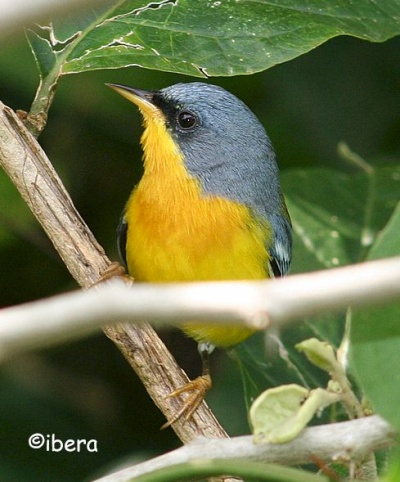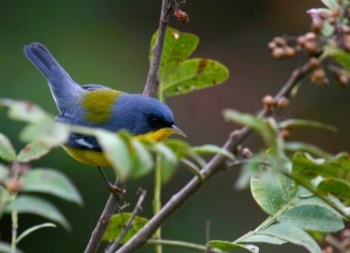- Setophaga pitiayumi
Parula pitiayumi
Identification
11 cm (4.3 ins). Blue-gray upperparts, green back patch, two white wingbars, yellow underparts, becoming orange on the breast. The male has a black patch from the bill to behind the eye. Females are slightly duller, and lack black on the head. The immature has dull plumage, lacks the wing bars, and has a gray band on the breast.
Similar Species
Northern Parula is very similar, except it has white eye crescents, and the male does not have the black patch on the face. Hybrids are frequent in Texas, so caution is warranted.
Distribution
Southernmost Texas, northwest Mexico, south through Central America, Colombia, Ecuador, Peru and Bolivia to northern Argentina, as well as east to Trinidad and Tobago, northeastern Brazil and south to Uruguay.
Taxonomy
There are 9 subspecies,1 with a wide range of plumage tones.
- S. p. nigrilora - southern Texas (lower Rio Grande Valley) to eastern Coahuila and northern Veracruz
- S. p. pulchra - Sierra Madre Occidental of northwestern Mexico (Sonora to Jalisco)
- S. p. insularis - Tres Marías Islands (off western Mexico) and adjacent Nayarit
- S. p. graysoni - Socorro Island in Revillagigedo Islands off southern Baja California
- S. p. inornata - southern Mexico (north to southern Veracruz and northern Chiapas) south to northwestern Colombia (Córdoba)
- S. p. cirrha - Coiba Island (Panama)
- S. p. pacifica - western side of Andes from Colombia to northwestern Peru, and eastern side of Andes of central and southern Peru and northern Bolivia
- S. p. alarum - Subtropical eastern Ecuador and northern Peru east of the Andes (south to Huánuco)
- S. p. pitiayumi - northern Colombia east to northern Brazil; eastern Bolivia east to northeastern Brazil, and south to Uruguay and northern Argentina; Trinidad and Tobago
Formerly placed in genus Parula.
Habitat
Subtropical hill forests - coniferous and mixed, especially those with abundant spanish moss and near water.
Behaviour
The diet includes insects, spiders and occasionally berries.
They build a domed nest in clumps of epiphytes, especially Spanish moss, in a tree. 2 eggs are laid and are incubated by the female for 12-14 days. Common cowbird host.
References
- Clements, J. F., T. S. Schulenberg, M. J. Iliff, S. M. Billerman, T. A. Fredericks, J. A. Gerbracht, D. Lepage, B. L. Sullivan, and C. L. Wood. 2021. The eBird/Clements checklist of Birds of the World: v2021. Downloaded from https://www.birds.cornell.edu/clementschecklist/download/
- Avibase
- ITIS
Recommended Citation
- BirdForum Opus contributors. (2025) Tropical Parula. In: BirdForum, the forum for wild birds and birding. Retrieved 9 May 2025 from https://www.birdforum.net/opus/Tropical_Parula
External Links
Search the Gallery using the scientific name:
Search the Gallery using the common name:
GSearch checked for 2020 platform.






